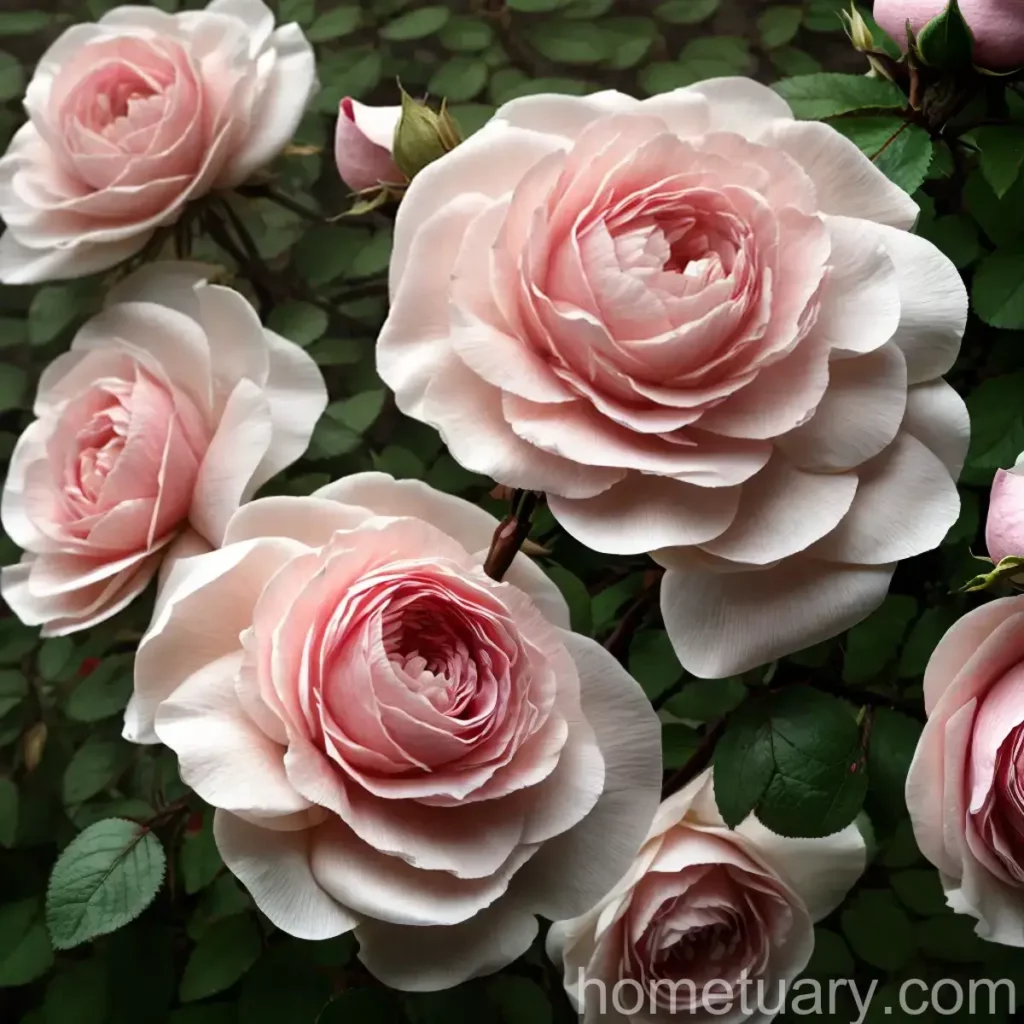The Hybrid Musk Rose (Rosa ‘Ballerina’)
When it comes to elegant and fragrant garden plants, roses invariably take the spotlight. There are numerous rose varieties, each with its own unique charm. In this blog post, we are going to delve into the captivating world of the Hybrid Musk Rose, specifically focusing on the enchanting Rosa ‘Ballerina’. We will explore its cultural requirements, uses, and how to care for this delightful rose variety. So, let’s embark on this journey to understand and appreciate the beauty of the hybrid musk rose.
What is a Plant: Hybrid Musk Rose (Rosa ‘Ballerina’)?
The Hybrid Musk Rose, scientifically known as Rosa ‘Ballerina’, is a lovely and delicate rose variety that belongs to the Rosaceae family. This hybrid musk rose was developed by Rev. Joseph Pemberton in 1937 by crossing the varieties ‘Trier’ and ‘Viridiflora’. Known for its profusion of charming, small, single flowers, this rose exudes a delightful musky fragrance that adds to its allure. The ‘Ballerina’ rose is a vigorous and hardy shrub with a long flowering season, making it a favorite among gardeners and rose enthusiasts.
Key Takeaways – Hybrid Musk Rose (Rosa ‘Ballerina’)
Before we delve deeper into the wonderful world of Rosa ‘Ballerina’, it’s essential to understand some key takeaways about this delightful rose variety.
- Common Name: Hybrid Musk Rose ‘Ballerina’
- Scientific Name: Rosa ‘Ballerina’
- Plant Type: Perennial Flower
- Height: 3-6 feet
- Spread: 3-4 feet
- Foliage: Deciduous
- Flower Color: Soft pink with a white center
- Fragrance: Highly Fragrant, Musky
- Hardiness Zones: 5-9
- Bloom Time: Late Spring to Fall
- Sun Exposure: Full Sun to Partial Shade
Now that we have an overview of the Rosa ‘Ballerina’, we can dive into the specifics of its cultivation, uses, care, and more.
Culture
Cultivating the Hybrid Musk Rose ‘Ballerina’ requires a good understanding of its cultural needs, including water, sunlight, fertilizer, soil, and pruning practices. Let’s explore these aspects in detail.
Water
Proper watering is essential for the healthy growth and blooming of the ‘Ballerina’ rose. Here are some key points to remember when it comes to watering this rose variety:
- Watering Frequency: Deep and thorough watering once or twice a week, especially during dry spells, is recommended.
- Watering Technique: Water at the base of the plant to ensure the roots receive an adequate amount of moisture.
- Avoid Overhead Watering: Overhead watering should be avoided, as it can lead to foliage diseases, particularly in humid climates.
Sunlight
Like most roses, the ‘Ballerina’ rose thrives in ample sunlight. Providing the right amount of sunlight is crucial for its growth and flowering.
- Sun Exposure: The ‘Ballerina’ rose requires full sun to partial shade. Aim for at least 6 hours of direct sunlight each day for optimal blooming.
Fertilizer
Feeding the Hybrid Musk Rose ‘Ballerina’ with the right nutrients is vital for strong, healthy growth and prolific flowering. Here’s how you can fertilize this rose variety effectively:
- Fertilizing Schedule: Apply a balanced fertilizer in early spring, just as new growth begins. Follow up with additional feedings during the growing season, as per the manufacturer’s instructions.
- Organic Matter: Incorporating organic matter, such as well-rotted manure or compost, into the soil can also provide essential nutrients.
Soil
The soil composition plays a significant role in the overall health and vigor of the ‘Ballerina’ rose. Ensuring the right soil conditions is crucial for its cultivation.
- Well-Draining Soil: The ‘Ballerina’ rose thrives in well-draining, loamy soil. Good drainage is essential to prevent waterlogged conditions that can lead to root rot.
- Soil pH: Aim for a slightly acidic to neutral pH range (6.0-7.0) for optimal growth and nutrient uptake.
Pruning
Pruning is an important aspect of rose care and is essential to maintain the health, shape, and blooming of the ‘Ballerina’ rose.
- Pruning Time: Prune the ‘Ballerina’ rose in early spring before new growth emerges. Remove dead, damaged, or crossing branches, as well as any thin or weak growth.
- Pruning Technique: Use clean, sharp pruners to make angled cuts just above an outward-facing bud. This encourages an open, balanced framework and promotes better air circulation within the plant.
Uses
The Hybrid Musk Rose ‘Ballerina’ offers a wide range of uses, from ornamental purposes to companion planting. Let’s explore some common uses for this delightful rose variety.
Garden Planting
- Border Planting: The ‘Ballerina’ rose is well-suited for border plantings, where its profusion of blooms can create a stunning visual display.
- Mixed Garden Beds: Planting ‘Ballerina’ roses in mixed garden beds alongside perennials and other flowering plants can add an enchanting touch to the landscape.
Cut Flowers
- The delicate, fragrant flowers of the ‘Ballerina’ rose make it an excellent choice for cut flower arrangements. Its charming blooms can adorn indoor spaces with their sweet fragrance and elegant appearance.
Fragrance
- The musky fragrance of the ‘Ballerina’ rose makes it a delightful addition to scented gardens. Planting it near patios, pathways, or seating areas can infuse the air with its captivating scent.
Container Planting
- Due to its compact size and attractive blooms, the ‘Ballerina’ rose is well-suited for container planting. It can adorn balconies, patios, and other outdoor spaces with its beauty.
Propagation
Propagation of the Hybrid Musk Rose ‘Ballerina’ can be achieved through several methods, including stem cuttings and layering techniques. These methods allow for the expansion of your rose garden and the sharing of this charming variety with fellow gardeners.
Container Popularity
The ‘Ballerina’ rose’s compact growth habit, profusion of blooms, and delightful fragrance make it a popular choice for container planting. Its versatility and beauty make it a standout performer in containers and pots.
Common Diseases
While the ‘Ballerina’ rose is relatively disease-resistant, it may still be susceptible to certain common rose diseases. Understanding these diseases and their symptoms can help in early detection and effective management.
Disease Diagnosis
- Powdery Mildew: A common fungal disease that typically appears as a powdery white coating on the leaves and buds.
- Black Spot: Identified by the presence of dark, circular spots on the leaves, often leading to yellowing and premature defoliation.
- Botrytis Blight: Also known as gray mold, this disease appears as fuzzy gray growth on flowers and buds, often occurring in wet or humid conditions.
Common Pests
Pests can sometimes pose a threat to the ‘Ballerina’ rose, although it is generally resilient to many common pests that affect roses. However, vigilance is key to early detection and intervention when dealing with pests.
- Aphids: Small, soft-bodied insects that cluster on new growth, causing distortion and yellowing of leaves.
- Spider Mites: These tiny pests can cause stippling and webbing on the undersides of leaves, leading to a weakened appearance of the plant.
Botanist’s Tips
As a botanist, here are some valuable tips for cultivating and caring for the Hybrid Musk Rose ‘Ballerina’:
- Mulching: Applying a layer of organic mulch around the base of the plant helps retain soil moisture, suppresses weeds, and provides a steady release of nutrients as it decomposes.
- Regular Inspections: Periodically examine the ‘Ballerina’ rose for any signs of pests, diseases, or nutrient deficiencies. Early detection allows for prompt intervention and management.
Fun Facts
- The ‘Ballerina’ rose was named for its resemblance to a dancer’s skirt, with its delicate, pink blooms evoking a sense of grace and elegance.
- This rose variety is a prolific bloomer, often producing clusters of flowers that create a charming display in the garden.
Links to External Resources
For further information on the Hybrid Musk Rose ‘Ballerina’ and other related topics, consider exploring the following resources:
- American Rose Society
- Royal Horticultural Society – Growing Roses
- University of California Agriculture and Natural Resources – Roses in the Garden
As we conclude our journey into the captivating world of the Hybrid Musk Rose ‘Ballerina’, we hope that this exploration has deepened your appreciation for this delightful and enchanting rose variety. From its musky fragrance to its charming blooms, the ‘Ballerina’ rose continues to captivate the hearts of gardeners and rose enthusiasts alike, adding a touch of elegance and beauty to gardens around the world. Whether planted in borders, containers, or scented gardens, the ‘Ballerina’ rose remains a timeless favorite, showcasing its grace and allure with every bloom.















